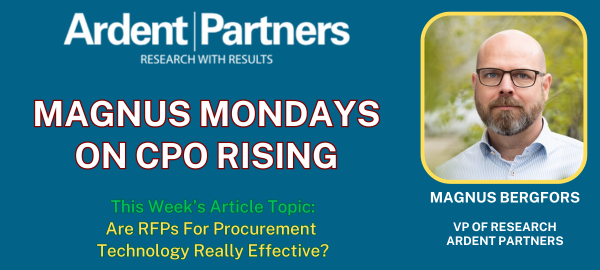Today’s topic might seem a little ironic given that analysts are infamous among technology providers for issuing long and demanding questionnaires about everything under the sun. But for a buying organization, there are several issues with trying to select, or even shortlist, solution providers based on RFPs. In today’s article, I will discuss some of these issues.
You could argue that much of this isn’t unique to procurement technology and that any good procurement professional should be able to buy just about anything. The problem, however, is that you have no other subject matter experts in the organization to lean on. (Many of the issues discussed in this article are likely true for buying other types of enterprise software as well, but I’ll stick to my lane and focus on procurement software.)
Do You Know What You Don’t Know?
A big problem for most buying organizations is that they are buried with day-to-day activities. Unless there is a specific role focused on procurement digitalization, there is a big risk that the knowledge about procurement technology is limited or even minimal. This presents many problems. Yes, an RFI can be used to collect information but if you don’t know what’s possible and what the various solutions actually do, how do you know what questions to ask? And who do you send it to?
Sending too high-level RFIs to a random collection of solution providers is generally a waste of everybody’s time. The solution providers must spend time responding to questions that have a low likelihood of leading to business (if they bother to answer at all) and the buying organization will be bombarded with sales calls and emails from solution providers that probably are irrelevant to them.
So, the first step for any prospective procurement technology buyer must be to define the business objective or the outcome you are trying to achieve and make sure you have at least a high-level understanding of the market for the relevant solutions and solution providers. Working with an analyst firm, such as Ardent Partners, is a good option at this stage.
How Do You Compare the Answers?
So, you have a working knowledge of the market. Even so, there’s an art to knowing what questions to ask and how to ask those questions. In my experience, buying organizations tend to ask too many specific, detailed questions that risk disqualifying solution providers that might have a solution that will solve the issue at hand just because they are addressing the problem differently.
And even if you ask very specific questions, the solution providers will end up with slightly different interpretations of the questions, which results in answers that are difficult to compare. Some will respond with a simple “yes” and others will provide a 2,000-word essay with attached documentation.
Another issue is that some providers will bend over backward to respond with a “yes, we support that” even if it requires a complex workaround, while others will be, almost naively, honest and say “no, we don’t support that” even if it can be done with some configuration. (I’ve found the latter to be most common with founder-led or very technology-focused solution providers).
So, make sure to focus the questions on how the solution providers can help you achieve your business objectives, rather than on what specific features and functionality they have. Then focus on demos (but make sure to create your own demo script and even add some changes during the demo to assess the flexibility of the solutions), and, if possible, sett up sandbox environments for trials or run pilots.
How Do You Ask About Some of the Most Important Stuff?
For longer-term success, there is a need to make sure culture and vision are aligned between buyer and solution provider. While it’s fairly straightforward to ask about vision, it’s pretty hard to get a real feel for it without face-to-face meetings. The cultural fit might be even harder to assess, even when meeting face-to-face, especially if you are only meeting individual sales reps.
If you are making any sort of significant investment, it’s worthwhile to meet with the leadership of the solution providers. Also, attend solution provider conferences to get a better understanding of the vision and culture of various solution providers.
Focus More on Business Objectives and Less on Features
In summary, avoid long RFPs and focus more on what you are trying to achieve rather than exactly how to get there. If you lock in on the how too early, you might miss out on potentially better solutions that have a different approach. We are biased, but it’s typically a very good idea to work with an analyst firm such as Ardent Partners to help focus on a shortlist of solution providers that you can then evaluate more collaboratively. We are, after all, experts on the entire S2P solution provider market and know most of the solution providers. For those that we don’t know, we can quickly assess given our experience, knowledge, and frameworks to see if they are realistic options.
As always, don’t hesitate to reach out to Ardent Partners if you want to start a discussion.
RELATED RESEARCH
Supply Management Technology: Key Solution Selection Criteria
Magnus Mondays — Contract Lifecycle Management: A Different but Critical Procurement Technology
Procurement Needs to Pivot to a Results-Based Approach to Evaluating Technology


